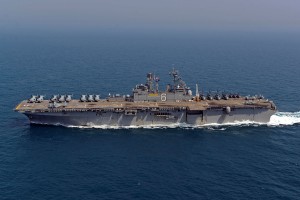2014-04-12 More than 20 US Navy and Republic of Korea vessels, tens of air assets and more than 14,000 participating troops kicked of Exercise Ssang Yong on 27 March 2014.
It is one of the largest amphibian operational exercises in Asia, with the US Navy 7th Fleet and the 3rd Marine Expeditionary Brigade (3rd MEB) involved, as well as the ROK Navy from Flotilla 5 and a small detachment of the Australian Army.
The deployed US Navy fleet units included the Bonhomme Richard Amphibious Ready Group (ARG) and the Boxer ARG, which means Ospreys, Cobras, Sea Stallions, Hueys and some Seahawks swarmed over sea and ground forces during the landings.
Approximately 7,500 U.S. Marine Corps and 2,000 U.S. Navy personnel participated in the exercise with approximately 3,500 ROK Marine Corps, 1,000 ROK navy and 130 Australian army forces.

Exercise Ssang Yong demonstrated the ability of a Marines Expeditionary Brigade headquarters to coordinate multiple forces arriving in theatre via amphibious shipping, along with a ROK Regimental Landing Team, into one amphibious fighting force.
The wrap up of the exercise was summarized by the USN report below:
By Mass Communication Specialist 1st Class Carla Burdt, Amphibious Squadron 11 Public Affairs
USS BONHOMME RICHARD – At Sea (NNS) 4/6/14
Sailors and Marines from Expeditionary Strike Group Seven (ESG 7) and the 3rd Marine Expeditionary Brigade (3d MEB), along with their counterparts from the Republic of Korea (ROK), wrapped up exercise Ssang Yong 2014, April 5.
Ssang Yong, Korean for “twin dragons,” is an annual, bilateral amphibious assault exercise conducted in the U.S. 7th Fleet area of operation by Navy and Marine forces with the ROK in to strengthen interoperability and working relationships across the range of military operations from disaster relief to complex, expeditionary operations.
“What Ssang Yong 2014 is all about is demonstrating the capabilities of the Navy and Marine Corps amphibious team,” said Rear Adm. Hugh Wetherald, Commander ESG 7. “There is more than just amphibious warfare, and that is working with our partners, working with our allies. This is one of those unique opportunities that we have to really integrate ourselves and work as an equal team as we project power.”
The exercise was the first to include a joint, combined command and control headquarters which was led by Wetherald; ROK Rear Adm. Chun Jung-soo, commander, Flotilla Five; Brig. Gen. Paul Kennedy, commanding general, 3d MEB; and ROK Brig. Gen. Cho Kang-jae, deputy commander Landing Force.
More than 20 ships and 14,000 Sailors and Marines participated in the exercise.
“I’ve always said that our navies, any of our partners’ navies, are stronger when we work together than when we work apart,” said Wetherald. “As we brought the two flagships together, 500 yards apart from each other, that was really emblematic of the capability we have out here and how strong we are when we work together.”
During Ssang Yong 2014, 13 landing craft, including Landing Craft Air Cushion and Landing Craft Utility transported 263 pieces of equipment weighing a total of 3,328,494 pounds. The equipment transported included, six M1A1 tanks; High Mobility Multipurpose Wheeled Vehicles; Medium Tactical Vehicle Replacements; Internally Transportable Vehicles; and, other equipment between Marine Prepositioning Forces (MPF) and Navy assets.
“We moved more than three million pounds of equipment over five days via landing craft,” said Capt. Michael Allen, Commander Amphibious Squadron 11 (PHIBRON 11) combat cargo officer. “During the rehearsal and ‘D-Day,’ the dynamic schedule came together and we executed perfectly. For two nations to come together and achieve what we did was phenomenal. We learned how to best communicate in order to identify priorities and get people and equipment to the beach.”
ESG 7 and 3d MEB also flew more than 800 aerial missions in support of the exercise and 74 U.S. and Korean amphibious assault vehicles were used during the amphibious landing. For Ssang Yong 2014, ESG 7 included the Bonhomme Richard Amphibious Ready Group (ARG) and Boxer ARG and 3d MEB included the 31st Marine Expeditionary Unit (MEU) and the 13th MEU.
“This was a tremendously complex exercise with thousands of Marines and thousands of Navy Sailors, over 20 ships coming together and, then, immediately executing,” said Wetherald. “It was a true and tried example of a mature relationship.”
The video above is of U.S. Marines and Sailors with the 31st Marine Expeditionary Unit (31st MEU) conducting flight operations on the USS Bonhomme Richard (LHD-6) at sea in preparation for Exercise Ssang Yong 2014.
Credit: III Marine Expeditionary Force Combat Camera, 3/26/14

